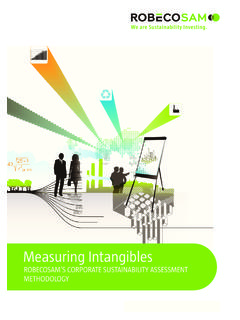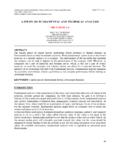Transcription of Criteria | Corporates | Utilities: Key Credit Factors For ...
1 Criteria | Corporates | Utilities: Key Credit Factors For The RegulatedUtilities IndustryPrimary Credit Analysts:Richard Creed, Melbourne (61) 3-9631-2045; A Eiseman, New York (1) 212-438-7666; Ferraris, Milan (39) 02-72111-207; Fuentes, Buenos Aires (54) 114-891-2131; Grosberg, New York (1) 212-438-6043; Iyer, Melbourne (61) 3-9631-2034; W Jepsen, CFA, New York (1) 212-438-2529; Kindahl, Stockholm (46) 8-440-5907; D Lindstrom, Stockholm (46) 8-440-5922; D Martin, Toronto (1) 416-507-2560; A Myers, New York (1) 212-438-4229; Nikas, New York (1) 212-438-7807; M Olaya-Rotonti, New York (1) 212-438-8668; Shibata, Tokyo (81) 3-4550-8437; A Shipman, CFA, New York (1) 212-438-7676; Stenqvist, Stockholm (46) 8-440-5925; Tsoneva, CFA, London (44) 20-7176-3489; J Davidson, London (44) 20-7176-6306; Officer:Mark Puccia, New York (1) 212-438-7233.
2 Of ContentsSCOPE OF THE CRITERIASUMMARY OF THE CRITERIAIMPACT ON OUTSTANDING RATINGSEFFECTIVE DATE AND 19, 2013 11220271 | 301135083 Table Of Contents (cont.)METHODOLOGYPart I-- business Risk AnalysisPart II--Financial Risk AnalysisPart III--Rating ModifiersAppendix--Frequently Asked QuestionsRELATED Criteria AND 19, 2013 21220271 | 301135083 Criteria | Corporates | Utilities: Key Credit Factors For The Regulated UtilitiesIndustry(Editor's Note:This Criteria article supersedes "Key Credit Factors : business And Financial Risks In The Investor-OwnedUtilities industry ," published Nov.)
3 26, 2008, "Assessing Utility Regulatory Environments," Nov. 7, 2007, and "RevisedMethodology For Adjusting Amounts Reported By GAAP Water Companies For Infrastructure Renewals Accounting," , 2010.) & Poor's Ratings Services is refining and adapting its methodology and assumptions for its Key CreditFactors: Criteria For Regulated utilities . We are publishing these Criteria in conjunction with our corporate Criteria (see" corporate Methodology, published Nov. 19, 2013). This article relates to our Criteria article, "Principles Of CreditRatings," Feb.
4 16, Criteria article supersedes "Key Credit Factors : business And Financial Risks In The Investor-Owned UtilitiesIndustry," Nov. 26, 2008, " Criteria : Assessing Utility Regulatory Environments," Nov. 7, 2007, and "RevisedMethodology For Adjusting Amounts Reported By GAAP Water Companies For Infrastructure RenewalsAccounting," Jan. 27, OF THE Criteria apply to entities where regulated utilities represent a material part of their business , other than power, water, sewer, gas, and electric cooperative utilities that are owned by federal, state, or localgovernmental bodies or by ratepayers.
5 A regulated utility is defined as a corporation that offers an essential ornear-essential infrastructure product, commodity, or service with little or no practical substitute (mainly electricity,water, and gas), a business model that is shielded from competition (naturally, by law, shadow regulation, or bygovernment policies and oversight), and is subject to comprehensive regulation by a regulatory body or implicitoversight of its rates (sometimes referred to as tariffs), service quality, and terms of service.
6 The regulators base therates that they set on some form of cost recovery, including an economic return on assets, rather than relying on amarket price. The regulated operations can range from individual parts of the utility value chain (water, gas, andelectricity networks or "grids," electricity generation, retail operations, etc.) to the entire integrated chain, fromprocurement to sales to the end customer. In some jurisdictions, our view of government support can also affect thefinal rating outcome, as per our government-related entity Criteria (see "General Criteria : Rating Government-RelatedEntities: Methodology and Assumptions," Dec.)
7 9, 2010).SUMMARY OF THE & Poor's is updating its Criteria for analyzing regulated utilities , applying its corporate Criteria . The Criteria forevaluating the competitive position of regulated utilities amend and partially supersede the "Competitive Position"section of the corporate Criteria when evaluating these entities. The Criteria for determining the cash flow 19, 2013 31220271 | 301135083assessment partially supersede the "Cash Flow/Leverage" section of the corporate Criteria for the purpose ofevaluating regulated utilities .
8 The section on liquidity for regulated utilities partially amends existing Criteria . All othersections of the corporate Criteria apply to the analysis of regulated ON OUTSTANDING Criteria could affect the issuer Credit ratings of about 5% of regulated utilities globally due primarily to theintroduction of new financial benchmarks in the corporate Criteria . Almost all ratings changes are expected to be nomore than one notch, and most are expected to be in an upward DATE AND Criteria are effective immediately on the date of I-- business Risk AnalysisIndustry the framework of Standard & Poor's general Criteria for assessing industry risk, we view regulated utilities as a"very low risk" industry (category '1').
9 We derive this assessment from our view of the segment's low risk ('2')cyclicality and very low risk ('1') competitive risk and growth our view, demand for regulated utility services typically exhibits low cyclicality, being a function of such key driversas employment growth, household formation, and general economic trends. Pricing is non-cyclical, since it is usuallybased in some form on the cost of providing assess cyclicality for regulated utilities as low risk ('2'). utilities typically offer products and services that areessential and not easily replaceable.
10 Based on our analysis of global Compustat data, utilities had an averagepeak-to-trough (PTT) decline in revenues of about 6% during recessionary periods since 1952. Over the same period, utilities had an average PTT decline in EBITDA margin of about 5% during recessionary periods, with PTT EBITDA margin declines less severe in more recent periods. The PTT drop in profitability that occurred in the most recentrecession (2007-2009) was less than the long-term an average drop in revenues of 6% and an average profitability decline of 5%, utilities ' cyclicality assessmentcalibrates to low risk ('2').









